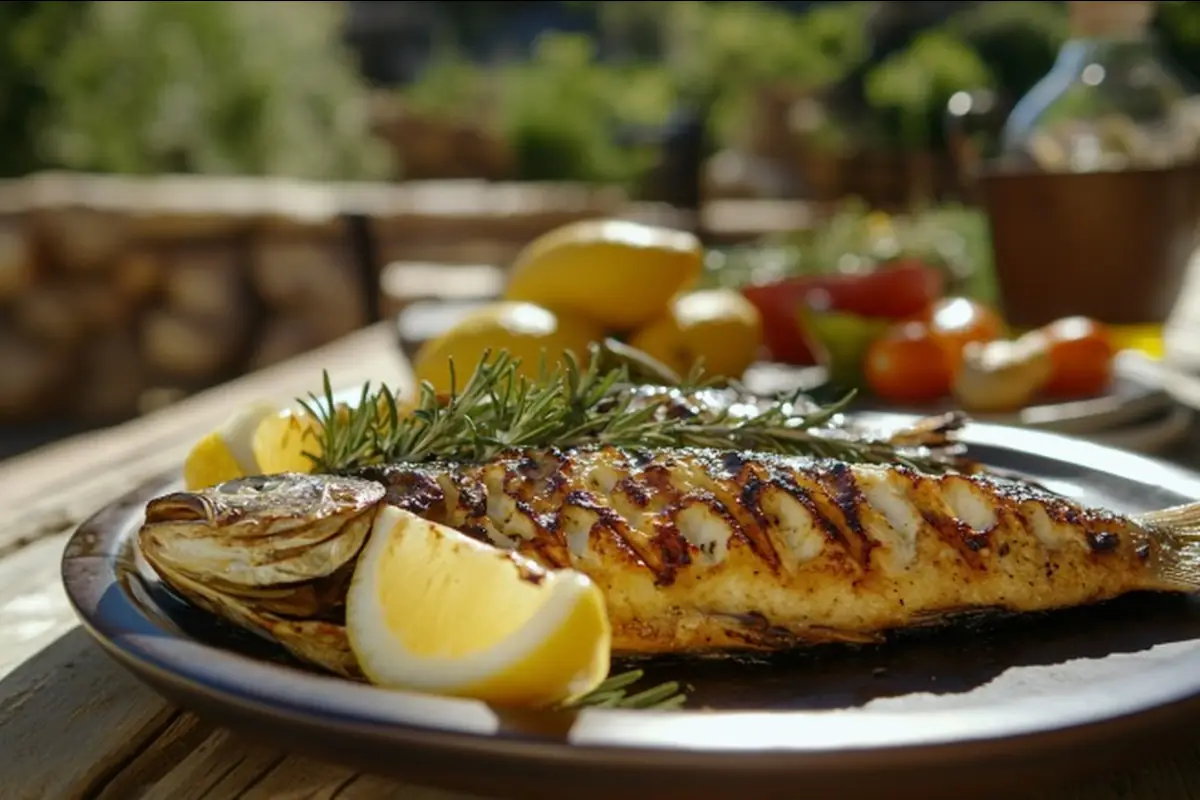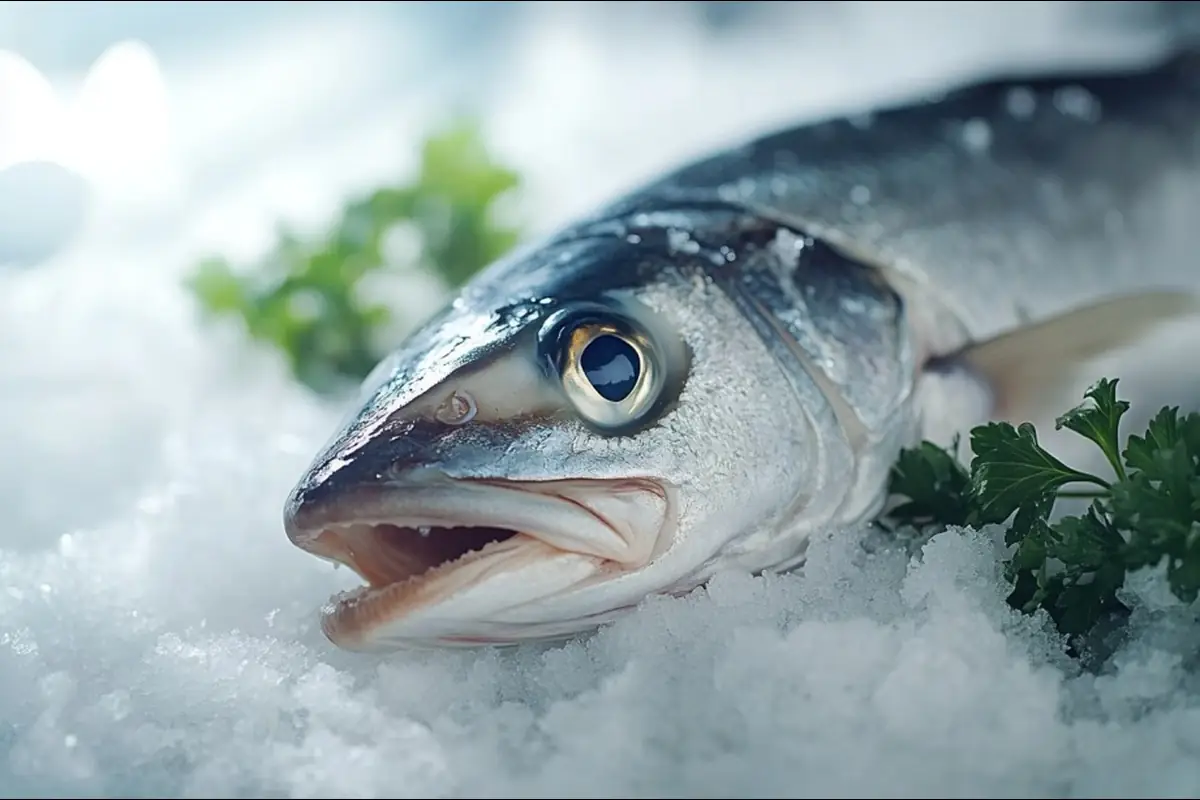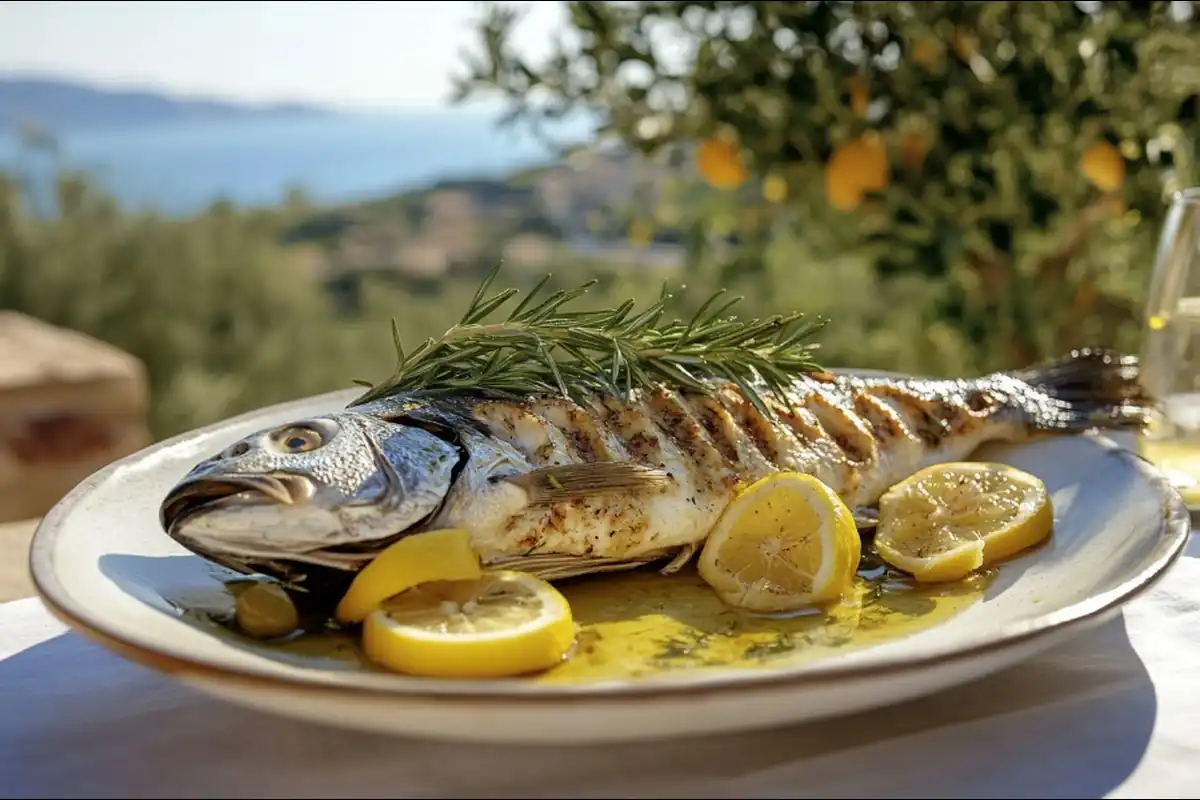1. What Makes Branzino a Popular Choice?
Is branzino a good fish to eat? This question is answered by its widespread popularity, thanks to its mild flavor, versatility in the kitchen, and impressive health benefits. Known as European sea bass, branzino is a staple in Mediterranean cuisine and has earned its place in global dining for all the right reasons.
1.1 Branzino in Mediterranean Cuisine
The roots of branzino lie in the Mediterranean, where it plays a starring role in many traditional dishes. Its adaptability is one of its strongest attributes. Whether it’s grilled and drizzled with olive oil or baked with a medley of herbs and lemon, branzino embodies the essence of Mediterranean cooking: simplicity paired with vibrant flavors.
One reason branzino is so loved is its mild, slightly sweet taste. Unlike fish with a stronger flavor, branzino appeals to a broad audience, even those new to seafood. Its firm yet flaky texture is another reason chefs and home cooks alike favor it.
1.2 The Key Question: Is Branzino a Good Fish to Eat?
The central question—is branzino a good fish to eat?—can be answered with a resounding “yes.” Here’s why:
- Health Benefits: Branzino is packed with nutrients like protein, omega-3 fatty acids, and vitamins.
- Culinary Flexibility: Its mild flavor and easy preparation methods make it suitable for various dishes.
- Sustainability: Many branzino farms follow sustainable practices, ensuring that your choice doesn’t harm the environment.
The upcoming sections will dive deeper into these aspects, providing you with all the information you need to decide if branzino deserves a place in your diet.
2. Nutritional and Health Benefits of Branzino
Is branzino a good fish to eat? Absolutely! Branzino is more than just a tasty fish; it’s a nutritional powerhouse that provides essential nutrients to support a healthy lifestyle. Its lean profile and impressive range of vitamins and minerals make branzino a standout option for anyone looking to add healthy seafood to their diet.
2.1 Nutritional Profile of Branzino
Branzino is a nutrient-rich fish, boasting an excellent balance of macronutrients and micronutrients. Here’s an overview of its nutritional content per 100 grams:
| Nutrient | Amount | Why It’s Important |
|---|---|---|
| Protein | ~20g | Supports muscle growth, repair, and overall body function. |
| Omega-3 Fatty Acids | ~0.8g | Essential for heart health, brain function, and reducing inflammation. |
| Vitamin B12 | ~2.5μg | Helps with red blood cell formation and energy production. |
| Vitamin D | ~3.5μg | Supports bone strength, immunity, and mental well-being. |
| Selenium | ~36μg | Acts as an antioxidant, protecting cells from damage caused by free radicals. |
| Phosphorus | ~210mg | Important for strong bones and teeth, as well as energy metabolism. |
Compared to fattier fish like salmon, branzino is a leaner option with lower fat content but still provides ample protein and omega-3 fatty acids.
2.2 Dietary Suitability
Branzino’s nutritional profile makes it a perfect addition to various diets:
- Low-Calorie Diets: With only about 120 calories per 100 grams, branzino is an excellent option for those watching their caloric intake.
- Mediterranean Diet: As a traditional Mediterranean fish, branzino fits seamlessly into this heart-healthy eating pattern.
- Low-Carb and Keto Diets: For those wondering, ‘Is branzino a good fish to eat?’, its suitability across diets like Mediterranean, keto, and low-calorie eating patterns makes it an easy choice for health-conscious individuals. Its high protein and low carbohydrate content make it a suitable choice for those limiting carbs.
Another major advantage of eating branzino fish is its low mercury levels. Unlike larger predatory fish such as tuna or swordfish, branzino is a good fish to eat because it is considered safe for frequent consumption by children and pregnant women.
2.3 Eating Branzino: Why It’s Good for Your Health
Adding branzino to your diet can lead to several health benefits, thanks to its nutrient composition:
- Heart Health: Omega-3 fatty acids in branzino help lower triglyceride levels, reduce inflammation, and support healthy blood pressure.
- Brain Function: DHA and EPA, the omega-3s found in branzino, play a critical role in maintaining cognitive health and may reduce the risk of neurodegenerative diseases.
- Skin and Hair: Selenium and omega-3s promote glowing skin and stronger hair by combating oxidative stress and nourishing cells.
- Energy Boost: The combination of vitamin B12 and lean protein provides sustained energy and aids metabolism.
Its versatility in dishes further enhances its appeal—whether part of a balanced dinner or a refreshing lunch, branzino contributes positively to your overall well-being.
3. Is Eating Branzino Sustainable? Exploring Ethical Sourcing
Sustainability is a key consideration for seafood lovers, and branzino holds its own as a relatively eco-friendly choice. Understanding how branzino is farmed or sourced can help you make informed decisions about enjoying this fish responsibly.
3.1 Sustainability Perspective
Branzino is primarily farmed in Europe, especially in Mediterranean countries like Greece, Turkey, and Italy, making it a top choice for those wondering, “Is branzino a good fish to eat?” Modern aquaculture practices have made farming branzino more sustainable than ever. Key points include:
- Efficient Farming Practices: Branzino farms use advanced techniques that minimize environmental impact, such as recirculating aquaculture systems (RAS) that reduce water waste.
- Controlled Diets: Farmed branzino is fed a balanced diet designed to promote growth while reducing the strain on wild fish stocks.
- Low Carbon Footprint: Compared to other protein sources, farmed branzino has a relatively lower carbon footprint, making it a greener choice.
However, not all farming practices are created equal. Choosing certified sustainable options—such as those labeled by the Aquaculture Stewardship Council (ASC)—ensures ethical sourcing.
3.2 Local vs. Imported Branzino
When considering whether to buy locally sourced or imported branzino, here are a few things to keep in mind:
- Freshness: Locally sourced branzino is often fresher, as it spends less time in transit.
- Cost-Effectiveness: Imported branzino may sometimes be more affordable, especially if it’s farmed in regions with lower production costs.
- Environmental Impact: Opting for local branzino can reduce the carbon footprint associated with long-distance shipping.
By supporting local fisheries or responsibly sourced imports, you can enjoy branzino without compromising sustainability.
3.3 Wild-Caught vs. Farmed Branzino
Both wild-caught and farmed branzino have their unique characteristics, and understanding the differences can help you choose based on your preferences:
| Aspect | Wild-Caught Branzino | Farmed Branzino |
|---|---|---|
| Taste | Richer, more complex flavor due to its natural diet. | Milder taste with consistent quality. |
| Texture | Firmer texture. | Slightly softer texture. |
| Environmental Impact | Potential overfishing concerns if not sourced sustainably. | Often farmed sustainably, minimizing strain on ecosystems. |
| Availability | Seasonal and harder to find. | Readily available year-round. |
For most people, farmed branzino is a reliable and sustainable choice, but wild-caught options offer a premium experience when sourced responsibly.
4. Cooking Branzino: Delicious Recipes and Easy Techniques
One of the reasons branzino is such a beloved fish is its versatility in the kitchen. From grilling to baking, this mild yet flavorful fish adapts beautifully to a variety of cooking techniques and cuisines.
4.1 What Does Branzino Taste Like?
Branzino, often celebrated as a top choice for seafood lovers, is praised for its mild, slightly sweet flavor. Is branzino a good fish to eat? Absolutely, especially for those new to seafood or who prefer a less “fishy” taste. Its firm yet flaky texture strikes a perfect balance, making branzino ideal for a variety of preparation methods.
When compared to similar fish:
- Snapper: Branzino is milder and less sweet.
- Sea Bass: Similar in flavor but branzino is lighter and flakier.
- Trout: Branzino has a cleaner taste with a smoother texture.
Its ability to absorb seasonings and marinades without losing its natural essence makes it a favorite in kitchens worldwide.
4.2 Popular Cooking Methods for Branzino
Preparing branzino is a culinary delight because its mild flavor pairs well with various techniques. Here are some popular methods:

- Grilling: Perfect for whole branzino, the char adds a smoky layer to its delicate flavor. Stuff it with herbs like rosemary and thyme for an aromatic finish.
- Baking: Baking branzino in parchment paper or foil locks in moisture and infuses the fish with the flavors of added seasonings.
- Pan-Frying: A quick method that creates a crispy skin while keeping the meat tender. Pair with a tangy sauce for balance.
- Steaming: Steamed branzino is light and healthy, often complemented by a ginger-soy glaze or citrusy dressing.
4.3 Branzino in Global Cuisines
Though branzino is most associated with Mediterranean cuisine, it plays a role in dishes from other parts of the world as well:
- Mediterranean: Whole roasted branzino with olive oil, lemon, and capers is a classic.
- Asian: In Chinese cuisine, branzino is often steamed with soy sauce, ginger, and scallions.
- Middle Eastern: Grilled branzino is served with tahini, fresh herbs, and warm flatbreads.
These cultural interpretations of eating branzino fish highlight its adaptability and universal appeal.
4.4 Tips for Beginner Cooks
Cooking branzino at home might seem daunting, but it’s easier than you think. Follow these tips for a seamless experience:
- Cleaning and Deboning: Ask your fishmonger to prepare the fish for you, or use a small knife to remove scales and bones at home.
- Seasoning: Keep it simple—salt, pepper, olive oil, and lemon are enough to highlight its natural flavors.
- Cooking Time: Branzino cooks quickly due to its thin fillets. Overcooking can make it dry, so aim for 10 minutes per inch of thickness.
- Serving: Branzino pairs wonderfully with roasted vegetables, light salads, or even crusty bread and a glass of white wine.
5. Economic and Practical Considerations
While branzino is celebrated for its taste and health benefits, its cost and practicality are equally important. Whether you’re a seasoned seafood enthusiast or a curious first-timer, understanding the economic and practical aspects of branzino can help you make better choices.
5.1 Affordability and Cost
Branzino is often considered a mid-range seafood option. It’s not as expensive as premium fish like halibut or swordfish, but it’s pricier than everyday options like tilapia or cod.
Here’s what affects the cost of branzino:
- Farming vs. Wild-Caught: Wild-caught branzino is rarer and more expensive due to limited supply and the effort required to catch it sustainably. Farmed branzino is more affordable and widely available.
- Seasonality: Prices may fluctuate depending on the season and availability, particularly for wild-caught varieties.
- Location: Imported branzino can cost more due to shipping fees, while locally sourced options are often more budget-friendly.
Tips for Budget-Friendly Buying:
- Look for sales at your local fish market or grocery store.
- Consider frozen branzino—it’s usually more affordable and still high-quality if sourced responsibly.
5.2 Storage and Freshness Tips
To fully enjoy the flavor and texture of branzino, proper storage is crucial. Here are some guidelines to keep your fish fresh:

For Fresh Branzino:
- Store it in the coldest part of your refrigerator (32°F or 0°C).
- Place it on a bed of ice in a sealed container to maintain optimal freshness.
- Use it within 1-2 days of purchase.
For Frozen Branzino:
- Keep it in the freezer at 0°F (-18°C).
- When ready to cook, thaw it slowly in the refrigerator overnight to preserve its texture and flavor.
Signs of Fresh Branzino:
- Bright, clear eyes (if buying whole).
- Firm, translucent flesh with no unpleasant odor.
- Shiny, metallic skin with tightly adhering scales.
By following these tips, you can ensure the best quality whether you’re buying fresh or frozen branzino.
6. FAQs About Branzino
When it comes to branzino, common questions often arise about its quality, taste, and safety. Let’s address some of the most frequently asked questions to clear up any uncertainties.
6.1 Is branzino high quality?
Yes, branzino is widely regarded as a high-quality fish. Its mild flavor, tender texture, and adaptability make it a favorite among chefs and home cooks alike. Moreover, branzino is often sustainably farmed, ensuring consistent quality and freshness. Wild-caught varieties, when available, are also highly prized for their richer taste.
6.2 Is branzino fish high in mercury?
No, branzino is considered a low-mercury fish. This makes it a safe choice for frequent consumption, including for children and pregnant women. Its small size and short life cycle reduce the likelihood of mercury accumulation compared to larger predatory fish like tuna or swordfish.
6.3 What’s better, sea bass or branzino?
Branzino is a type of sea bass, specifically European sea bass, so the comparison often depends on context. If you’re considering other types of sea bass, such as black sea bass or Chilean sea bass, the differences lie in taste and texture:
Branzino: Mild, slightly sweet, and lighter, with a flaky texture.
Chilean Sea Bass: Richer, buttery, and more robust in flavor.
Black Sea Bass: Firm, sweet, and slightly stronger in taste.
Ultimately, it’s a matter of personal preference and how you plan to cook it.
6.4 What does branzino fish taste like to eat?
Branzino is known for its mild, clean flavor with a subtle sweetness. Its taste is versatile, making it ideal for a variety of seasonings and cuisines. The texture is delicate yet firm, ensuring that it holds up well to methods like grilling, baking, or steaming.
7. Addressing Myths and Misconceptions
Like any popular food, branzino has its share of myths and misconceptions. Let’s address these to provide clarity and ensure you make informed decisions about including branzino in your meals.
7.1 Is Branzino Overrated?
Some critics argue that branzino is overhyped, often claiming that it’s no different from other white fish. However, this notion doesn’t hold water when you consider the unique qualities branzino offers:
- Balanced Flavor: Its mild sweetness and delicate texture make it a versatile ingredient that complements a wide range of dishes.
- Accessibility: Branzino is readily available and easy to cook, making it an excellent choice for home chefs of all skill levels.
- Health Benefits: Packed with omega-3s, lean protein, and essential vitamins, branzino is not just delicious but also highly nutritious.
While it might not have the bold flavor of salmon or the buttery richness of Chilean sea bass, branzino’s subtle profile makes it a staple for those seeking light and healthy meals.
7.2 Mercury Content Clarification
There’s a misconception that all seafood contains dangerously high levels of mercury. While this may apply to some larger fish like tuna and swordfish, branzino is on the opposite end of the spectrum.
- Why Is Branzino Low in Mercury?
Branzino has a shorter life cycle and occupies a lower place on the food chain, reducing its exposure to mercury and other heavy metals. - Safe for Everyone: Its low mercury content makes it an excellent option for people who need to limit mercury intake, including pregnant women, young children, and frequent seafood eaters.
Understanding these facts dispels unnecessary fears and highlights why branzino is a safe and smart seafood choice.
8. Conclusion
Branzino is much more than just a Mediterranean favorite—it’s a fish that offers exceptional nutritional benefits, sustainable sourcing options, and incredible culinary versatility. Whether you’re exploring new recipes or looking for a healthy protein source, branzino is a choice that checks all the right boxes.
8.1 Summary of Key Points
Let’s recap why branzino is a good fish to eat:
- Health Benefits: Packed with omega-3 fatty acids, lean protein, and essential vitamins like B12 and D, branzino supports heart, brain, and skin health.
- Low Mercury Levels: Safe for frequent consumption, even for children and pregnant women.
- Sustainability: Farmed branzino is often a more eco-friendly option compared to other seafood.
- Culinary Versatility: Its mild flavor and adaptable texture make it suitable for grilling, baking, steaming, and more.
By addressing its nutritional profile, sustainability, and taste, branzino proves itself as a fish worth adding to your dining repertoire.
Are you ready to try branzino? Visit your local fish market or grocery store to find high-quality branzino and experiment with recipes that highlight its delicate flavors. Pair it with fresh Mediterranean ingredients like lemon, olive oil, and herbs for a meal that’s both delicious and healthy.


2 thoughts on “Is Branzino a Good Fish to Eat? Discover Its Health, Sustainability, and Culinary Appeal”